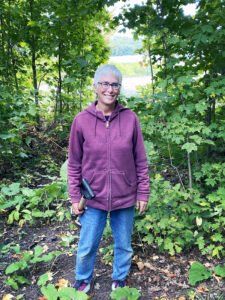By Art Kabelowsky, DNR Forest Health Communications, Fitchburg;
Arthur.Kabelowsky@wisconsin.gov or 608-335-0167
Andrea Billings insists that she doesn’t do all that much volunteering.
But if most people in Wisconsin regularly put in the time Billings does, a considerable dent would be made in the state’s dealings with invasive plant species.

Andrea Billings, of Oneida County, spends several days each year as a volunteer pulling invasive species out of state and county parks and natural areas. / Photo Credit: Mary Bartkowiak, Wisconsin DNR.
“(I do) little projects here and there,” Billings said in a recent telephone interview. “I love seeing Dutchman’s breeches, spring beauties and trilliums in the spring, sun dews and orchids in the sphagnum bogs, wintergreen as I walk the trails, and native yellow loosestrife along the shores of Buffalo (Lake).
“I live in such a beautiful place. I just love where we live, and I’d love to see it not taken over by the non-native invasives. They’re so aggressive, and our native plants aren’t. I just like to help,” Billings said.
Billings, who lives in rural Oneida County between St. Germain and Minocqua, retired in 2016 as a biology, botany and geology teacher at Lakeland Union High School in Minocqua.
Also in 2016, Billings was searching for something to get involved in when she heard about a program at the Clear Lake Campground Nature Center to promote volunteering at state natural areas. Excited by the thought that the program was exactly what she was looking for, she used the pamphlet to contact Wisconsin Department of Natural Resources (DNR) State Natural Areas Volunteer Coordinator Jared Urban.
“Jared connected with me … but the only projects he had were in southern Wisconsin,” Billings said. “Jared did say that garlic mustard was listed at Laurel Lake State Natural Area and that (DNR conservation biologist) Carly Lapin managed that area.
“In 2019, Alyssa Hoekstra, who worked under Lapin at Laurel Lake, went with me and showed me where it was. I’ve been pulling it there since 2019, twice a year. I’ve already been there once this year, and I’ll go back in a week or two.”
But that’s not the only place Billings visits with her gloves and boots on.
“2017 was the first time I ever saw purple loosestrife – and a lot of it – on Buffalo Lake, which is our local campground’s lake. I’ve been pulling it ever since. The first year, my husband and my son helped pull and dig mature purple loosestrife, mostly in two feet of water, because the water levels were high back then. We filled my husband Dennis’ Jon boat twice with at least eight construction-size bags of purple loosestrife.”
At the end of that summer, Billings tried to contact the DNR and others to see if some help could be brought in to fight the invasive plant. Steph Boismenue, Oneida County aquatic invasive species coordinator, stepped up by sending at least two people for one day in July to remove purple loosestrife from Buffalo Lake.
Billings has joined these teams every year and usually removes purple loosestrife one day before they arrive and then again later in the summer.
“We also found that with the lake levels going down, there were a lot of dead alders along the edge blocking my view of a few large plants which didn’t get removed,” Billings said. “So these plants sent out seed that traveled across the lake, and we had another crop on the southeast end of the lake. It’s a continual thing.”
After Lapin asked her about weeding turtle nesting sites in 2020, Billings was all in. “That was a lot of work! For the last two years, they’ve had these big, 12-by-12 boxes to protect the areas, and the lids are too big for me to lift off! My husband helped me for two years, but he’s done – so I guess so am I for this project!”
She said pulling invasives is her way of spending time in nature. “Going to Laurel Lake, it’s a lovely walk in there when the spring flowers are starting to bloom and the birds are migrating.”
“What drives me is my desire to not see special areas taken over by invasives. … I don’t want to see that happen to the state parks that we have in the Northwoods.”
To that end, Billings has recently been pulling garlic mustard at a site in the Northern Highland-American Legion (NHAL) State Forest under the direction of DNR Forest Invasive Plant Coordinator Mary Bartkowiak.
“Andrea has made a significant impact on the garlic mustard population at Clear Lake,” Bartkowiak said. “Her steadfast hand-pulling of this invasive plant has eliminated our use of herbicide at this location.”
“Soon, I may take on a project to remove valerian in a NHAL location near me,” Billings said. “A few hours don’t bother me, and I feel like I am helping a bit.”
Billings hadn’t thought about it at first, but she has come to understand how her efforts could set a good example for others who wouldn’t mind spending a few days each year fighting invasive species.
Anyone interested in looking into volunteer opportunities is invited to visit the DNR’s state natural areas volunteers webpage.
“If we could get a few hundred people doing this for just a few days a year, think of how much good it might do.”
